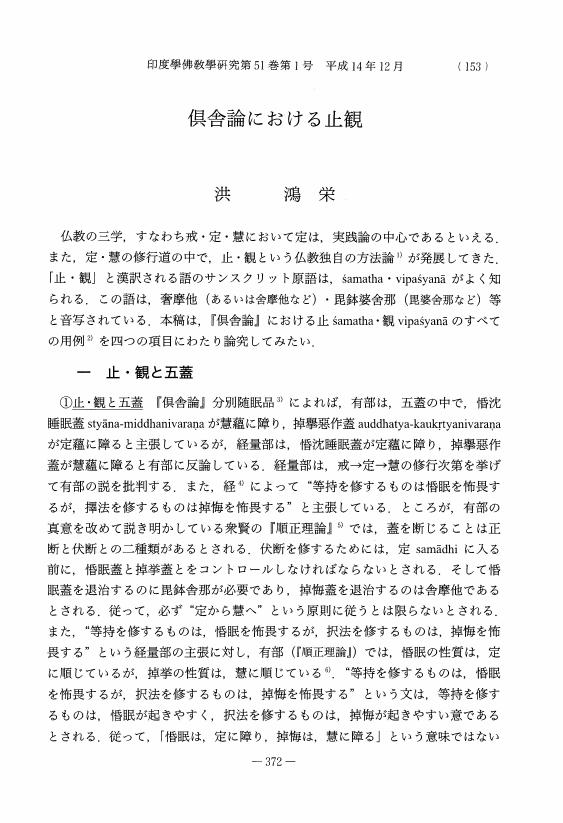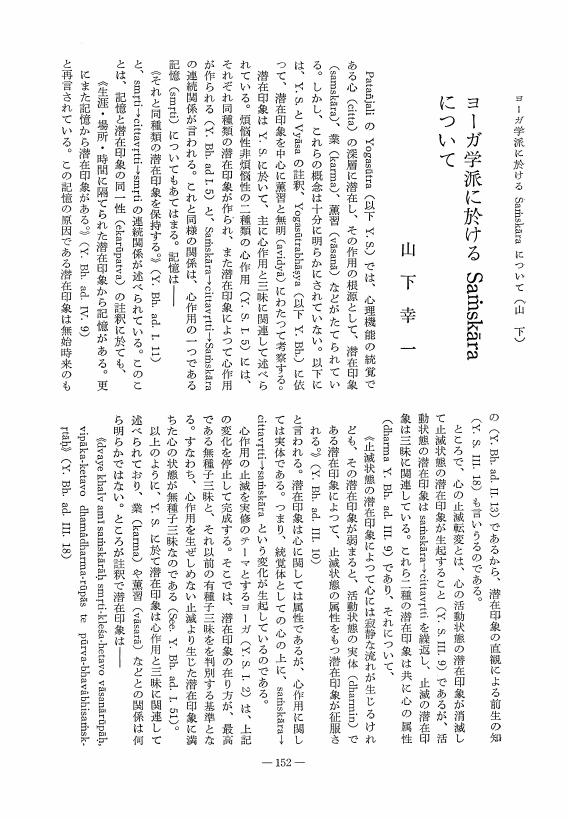1 0 0 0 パーリ経典に説かれる「九次第定」の成立と構造
- 著者
- 藤本 晃
- 出版者
- JAPANESE ASSOCIATION OF INDIAN AND BUDDHIST STUDIES
- 雑誌
- 印度學佛教學研究 (ISSN:00194344)
- 巻号頁・発行日
- vol.53, no.2, pp.891-888, 2005
1 0 0 0 原始仏教における止観
- 著者
- 中村 元
- 出版者
- JAPANESE ASSOCIATION OF INDIAN AND BUDDHIST STUDIES
- 雑誌
- 印度學佛教學研究 (ISSN:00194344)
- 巻号頁・発行日
- vol.23, no.1, pp.24-29, 1974
1 0 0 0 OA 倶舎論における止観
- 著者
- 洪 鴻栄
- 出版者
- JAPANESE ASSOCIATION OF INDIAN AND BUDDHIST STUDIES
- 雑誌
- 印度學佛教學研究 (ISSN:00194344)
- 巻号頁・発行日
- vol.51, no.1, pp.372-369, 2002-12-20 (Released:2010-03-09)
1 0 0 0 OA 『一休和尚法語』について
- 著者
- 飯塚 大展
- 出版者
- JAPANESE ASSOCIATION OF INDIAN AND BUDDHIST STUDIES
- 雑誌
- 印度學佛教學研究 (ISSN:00194344)
- 巻号頁・発行日
- vol.45, no.1, pp.259-262, 1996-12-20 (Released:2010-03-09)
1 0 0 0 OA 『一遍聖絵』に見る一遍の出家
- 著者
- 梅谷 繁樹
- 出版者
- JAPANESE ASSOCIATION OF INDIAN AND BUDDHIST STUDIES
- 雑誌
- 印度學佛教學研究 (ISSN:00194344)
- 巻号頁・発行日
- vol.32, no.1, pp.317-320, 1983-12-25 (Released:2010-03-09)
1 0 0 0 OA drsyanupalabdhi における知覚可能性の把握
- 著者
- 渡辺 俊和
- 出版者
- JAPANESE ASSOCIATION OF INDIAN AND BUDDHIST STUDIES
- 雑誌
- 印度學佛教學研究 (ISSN:00194344)
- 巻号頁・発行日
- vol.50, no.1, pp.333-331, 2001-12-20 (Released:2010-03-09)
- 被引用文献数
- 1
1 0 0 0 OA 本覚思想に対する批判論
- 著者
- 田村 芳朗
- 出版者
- JAPANESE ASSOCIATION OF INDIAN AND BUDDHIST STUDIES
- 雑誌
- 印度學佛教學研究 (ISSN:00194344)
- 巻号頁・発行日
- vol.21, no.2, pp.918-925, 1973-03-31 (Released:2010-03-09)
1 0 0 0 スィンド州における地名に関する一考察
- 著者
- 萬宮 健策
- 出版者
- JAPANESE ASSOCIATION OF INDIAN AND BUDDHIST STUDIES
- 雑誌
- 印度學佛教學研究 (ISSN:00194344)
- 巻号頁・発行日
- vol.43, no.2, pp.987-985, 1995
1 0 0 0 OA 密教觀法と自律訓練
- 著者
- 酒井 敬淳
- 出版者
- JAPANESE ASSOCIATION OF INDIAN AND BUDDHIST STUDIES
- 雑誌
- 印度學佛教學研究 (ISSN:00194344)
- 巻号頁・発行日
- vol.17, no.1, pp.199-201, 1968-12-25 (Released:2010-03-09)
1 0 0 0 天台学入門書としての「天台四教儀」と「天台法華宗義集」
- 著者
- Swanson Paul
- 出版者
- JAPANESE ASSOCIATION OF INDIAN AND BUDDHIST STUDIES
- 雑誌
- 印度學佛教學研究 (ISSN:00194344)
- 巻号頁・発行日
- vol.34, no.1, pp.52-56, 1985
1 0 0 0 日蓮と「法華験記」
- 著者
- 中尾 正己
- 出版者
- JAPANESE ASSOCIATION OF INDIAN AND BUDDHIST STUDIES
- 雑誌
- 印度學佛教學研究 (ISSN:00194344)
- 巻号頁・発行日
- vol.32, no.1, pp.377-380, 1983
1 0 0 0 シャンカラのカタ・ウパニシャット・バーシュヤについて (一)
- 著者
- 神館 義朗
- 出版者
- JAPANESE ASSOCIATION OF INDIAN AND BUDDHIST STUDIES
- 雑誌
- 印度學佛教學研究 (ISSN:00194344)
- 巻号頁・発行日
- vol.8, no.2, pp.575-577, 1960
1 0 0 0 OA 時宗遊行 (藤沢) 上人の道号について
- 著者
- 梅谷 繁樹
- 出版者
- JAPANESE ASSOCIATION OF INDIAN AND BUDDHIST STUDIES
- 雑誌
- 印度學佛教學研究 (ISSN:00194344)
- 巻号頁・発行日
- vol.35, no.1, pp.243-248, 1986-12-25 (Released:2010-03-09)
1 0 0 0 契沖と神道
- 著者
- 高神 信也
- 出版者
- JAPANESE ASSOCIATION OF INDIAN AND BUDDHIST STUDIES
- 雑誌
- 印度學佛教學研究 (ISSN:00194344)
- 巻号頁・発行日
- vol.30, no.2, pp.733-736, 1982
1 0 0 0 OA ヨーガ学派に於ける Samskara について
- 著者
- 山下 幸一
- 出版者
- JAPANESE ASSOCIATION OF INDIAN AND BUDDHIST STUDIES
- 雑誌
- 印度學佛教學研究 (ISSN:00194344)
- 巻号頁・発行日
- vol.25, no.1, pp.152-153, 1976-12-25 (Released:2010-03-09)
1 0 0 0 原坦山と「印度哲学」の誕生-近代日本仏教史の一断面-
- 著者
- 木村 清孝
- 出版者
- JAPANESE ASSOCIATION OF INDIAN AND BUDDHIST STUDIES
- 雑誌
- 印度學佛教學研究 (ISSN:00194344)
- 巻号頁・発行日
- vol.49, no.2, pp.533-541, 2001
1 0 0 0 OA 承応の鬩牆の一試論
- 著者
- 藤田 真証
- 出版者
- JAPANESE ASSOCIATION OF INDIAN AND BUDDHIST STUDIES
- 雑誌
- 印度學佛教學研究 (ISSN:00194344)
- 巻号頁・発行日
- vol.55, no.2, pp.724-727,1258, 2007-03-20 (Released:2010-03-09)
The central issue in the fraternal quarrel of the Joo period (1652-1655) is whether Saigin's thought deviated toward solipsism. At present this problem has not been sufficiently explored. Here I would like to examine the controversy on the basis of a document Saigin appears to have written earlier, namely the Fumonbonsho. There are insufficent materials upon which to base a comparison with Saigin's later thought, but it does seem that the quarrel had a serious impact. For this reason, the Fumonbonsho is an important source, and valuable for the development of Shinshu doctrine.
1 0 0 0 OA Yamuna の atman 論
- 著者
- 石飛 貞典
- 出版者
- JAPANESE ASSOCIATION OF INDIAN AND BUDDHIST STUDIES
- 雑誌
- 印度學佛教學研究 (ISSN:00194344)
- 巻号頁・発行日
- vol.26, no.2, pp.683-684, 1978-03-20 (Released:2010-03-09)
- 著者
- 計良 龍成
- 出版者
- JAPANESE ASSOCIATION OF INDIAN AND BUDDHIST STUDIES
- 雑誌
- 印度學佛教學研究 (ISSN:00194344)
- 巻号頁・発行日
- vol.55, no.1, pp.447-442,1227, 2006
In his <i>Madhyamakaloka</i> (MA) Kamalasila undertakes the following two kinds of proofs in order to show that entities do not have any permanent or impermanent ultimate intrinsic natures: (1) The proof of the absence of <i>sadhakapramana</i> (i. e., the valid cognition which can prove those intrinsic natures); (2) The counter-proof (<i>badhakapramana</i>) against the opponent's idea that an ultimate intrinsic nature is existent. In this paper we examine why Kamalasila undertakes both these proofs (1) (2) as explained above and how he logically connects both proofs. In the first proof (1) Kamalasila intends to show that the ultimate intrinsic natures of entities are simply imagined (<i>kalpita</i>) by the opponents. This first proof (1) is requisite for the second proof (2), which proves the negation of the opponents' imagination of those intrisic natures. On the other hand, both <i>vajrakanahetu</i> and <i>ekanekaviyogahetu</i>, which are stated in the counter-proof against the opponent's idea, can be regarded as the <i>[sadhya] viparyaye badhakapramanas</i> (i. e., the means of valid cognition which serves to refute the presence of reason in the opposite [of the property being proved]) which prove that the reason consisting in the nonperception of an imperceptible object (<i>adrsyanupalabdhihetu</i>), which is stated in the proof of the absence of <i>sadhakapramana</i>, does not have the fallacy of being inconclusive (<i>anaikantika</i>). Therefore, the present writer shows the possibility that undertaking both those proofs (1) (2) as explained above, Kamalasila tries to systematize the proof of <i>nihsvabhavata</i> by means of <i>viparyaye badhakapramana</i>.
1 0 0 0 OA 歐米におけるインド學・佛教學の動き
- 著者
- 中村 元
- 出版者
- JAPANESE ASSOCIATION OF INDIAN AND BUDDHIST STUDIES
- 雑誌
- 印度學佛教學研究 (ISSN:00194344)
- 巻号頁・発行日
- vol.12, no.2, pp.752-762, 1964-03-31 (Released:2010-03-09)









